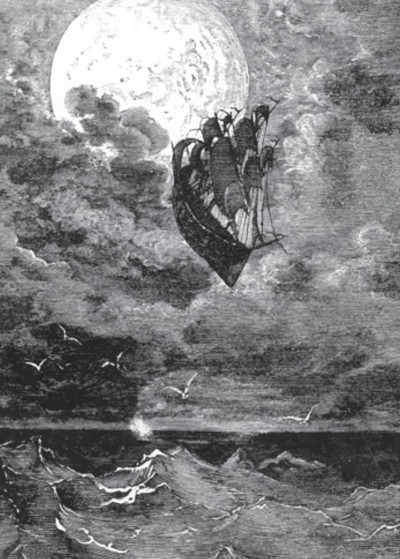A Voyage to the Moon is a section in The Adventures of Baron Munchausen. Gustave Doré would produce a series of drawings to illustrate this book in 1862, which was later published by Charles Furne, Paris.
Book illustration would be particularly prominent within the artist's career across the 1860s and 1870s, with this particular publication helping to attract new patrons as his reputation started to strengthen within Paris, before later spreading to London as well. The Adventures of Baron Munchausen themselves actually was made as a feature film, relatively recently, and so will be well known to many, even today. Whilst upon these adventures, the baron would complete a voyage to the moon, as depicted here, and this drawing features a tall ship in mid-air, with an image of the moon just behind. Such fantasy would have appealed to the artist who was a Romanticist by nature and enjoyed adding drama and emotion to his drawings. The ship itself is darkened on the side facing us and appears to be facing downwards, perhaps returning to the seas after its voyage into the sky. A number of birds swim around, welcoming the baron back. Waves crash around this dimly-lit scene in which the moon provides a strong contrast.
Doré's focus on this series was relatively brief, in comparison to some of his larger projects. He would have allowed others to create engravings from the drawings, and then moved on to other projects whilst the printing stage was completed. He became more efficient over time and learnt to concentrate on the skills that he performed the best, allowing other specialists to take on other phases of each project. He was handsomely paid for some of these commissions and consequently was able to hire as many engravers as he liked. Sevreal leading engravers that he worked with became famous in their own right, sometimes signing the artworks in the bottom right corner, alongside his own name. He continued to specialist as an illustrator in order to take advantage of the commissions on offer but secretly wanted to spend more time on developing his skills as a painter and sculptor, with the ambition of being considered a multi-talented artist by the end of his career. Sadly, he remains famous for his illustrations in the main, with other contributions considered more of a niche sideline.
There is a great mixture of literature within Doré's selection of book illustrations, with relatively modern publications featuring alongside ancient fables and even scenes from the Bible. He was able to adapt brilliantly from one project to the next, but it must be remembered that he did turn down some requests, perhaps where his expressive, dramatic style would not be appropriate. He produced around 10,000 drawings across his career and plenty of paintings and sculptures as well, leaving a huge body of work which remains popular within some sections of the public. Sadly, his connection to illustration rather than oil painting has meant that some are still unaware of his incredible talents, with the monotone nature of his work putting some people off. Those studying the techniques of drawing and etching will learn much from studying the various series that he worked on in the mid to late 19th century.




